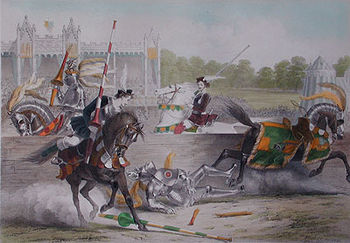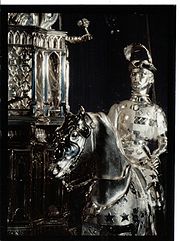
Eglinton Trophy
Encyclopedia

Archibald Montgomerie, 13th Earl of Eglinton
Sir Archibald William Montgomerie, 13th Earl of Eglinton KT, PC , known as Lord Montgomerie from 1814 to 1819, was a British Conservative politician...
to commemorate the medieval re-enactment known as the 'Eglinton Tournament
Eglinton Tournament of 1839
The Eglinton Tournament of 1839 was a re-enactment of a medieval joust and revel held in Scotland on Friday 30 August.It was funded and organized by Archibald Montgomerie, 13th Earl of Eglinton, and took place at Eglinton Castle, near Kilwinning in Scotland...
' held at Eglinton Castle
Eglinton Castle
Eglinton Castle was a large Gothic castellated mansion in Kilwinning, North Ayrshire, Scotland.-The castle :The ancient seat of the Earls of Eglinton, it is located just south of the town of Kilwinning...
, Kilwinning
Kilwinning
Kilwinning is a historic town in North Ayrshire, Scotland. It is known as The Crossroads of Ayrshire. The 2001 Census recorded it as having a population of 15,908.-History:...
, North Ayrshire in 1839.
Fund raising
A committee, including Lord BurghershJohn Fane, 11th Earl of Westmorland
General John Fane, 11th Earl of Westmorland GCB, GCH, PC , styled Lord Burghersh until 1841, was a British soldier, politician, diplomat and musician.-Background:...
, and chaired by the Marquess of Londonderry, King of the Tournament, was formed to set up a subscription to present Eglinton with a piece of plate, to commemorate the revival of the days of chivalry. Two hundred and thirty-nine people subscribed to the production of the trophy, each being limited to a maximum of twenty guineas (Circa £900 in modern terms).
Design and production

Edmund Cotterill was in charge of the design studio at Garrards in 1843 and at the time of the Empire Exhibition (1851) he was said to stand at the head of the class of artists who model for silversmiths and his productions, annually exhibited at Messrs Garrard, have earned that house a celebrity which no other can equal.
The trophy rises from a wide crennelated base on the sides of which are located the shields bearing the coats of arms of the fourteen Knights of the Tournament; a fifteenth shield is blank and four of the shields are in alcoves that extend from the base, accompanied by swords, quills, coronets, laurel leaf crown, etc. The 4 foot 8 inch (140cm) trophy rises up as a highly ornate Gothic pulpit sitting beneath a pinnacled canopy under which Jane Georgiana, Lady Seymour, the Queen of Beauty stands in the act of placing a wreath upon the brow of the Earl of Eglinton, Lord and victor of the Eglinton Tournament. Beside the figure of the earl are the Knight Marshal, Sir Charles Montolieu Lamb, with dismounted squire, and a halbardier, his escort and presentation party.
Two hunting dogs are also present, together with two pages, one male and one female, and a lady in waiting. The squire and the lady in waiting give the impression of exchanging glances. A coat of arms is also displayed on a shield behind Lady Seymour.
The glass case rises from an ornately carved eight sided wooden base emblazoned with four coats of arms and with a silver engraved dedicatory shield. This base stands around 2 feet and 10 inches (85 cm) in height.
Use
The trophy, presented to Archibald Montgomerie, 13th Earl of EglintonArchibald Montgomerie, 13th Earl of Eglinton
Sir Archibald William Montgomerie, 13th Earl of Eglinton KT, PC , known as Lord Montgomerie from 1814 to 1819, was a British Conservative politician...
in 1843, was originally housed within the library at Eglinton Castle
Eglinton Castle
Eglinton Castle was a large Gothic castellated mansion in Kilwinning, North Ayrshire, Scotland.-The castle :The ancient seat of the Earls of Eglinton, it is located just south of the town of Kilwinning...
and later at the Ayr County Hall in Ayr. It was featured and illustrated in The Illustrated London News of June 1843. The trophy is now kept, housed within its original glass and wood case, in Cunninghame House, headquarters of North Ayrshire Council, having been loaned to the people of Ayrshire by the 14th Earl it is however still the property of the present Earl of Eglinton.
It was moved to the Eglinton Country Park
Eglinton Country Park
Eglinton Country Park is located in the grounds of the old Eglinton Castle estate, Kilwinning, North Ayrshire, Scotland . Eglinton Park is situated in the parish of Kilwinning, part of the former district of Cunninghame, and covers an area of 400 hectares...
visitor centre in 1989 for the re-enactment that marked 150 years since the tournament. It is insured for an undisclosed, but considerable sum, and was lent to East Ayrshire Council for a short time in 2011 (April 30th to August 20th) as the centrepiece to an exhibition of James Henry Nixons (1802-1857) Eglinton Tournament prints at the Dick Institute in Kilmarnock
Kilmarnock
Kilmarnock is a large burgh in East Ayrshire, Scotland, with a population of 44,734. It is the second largest town in Ayrshire. The River Irvine runs through its eastern section, and the Kilmarnock Water passes through it, giving rise to the name 'Bank Street'...
.

